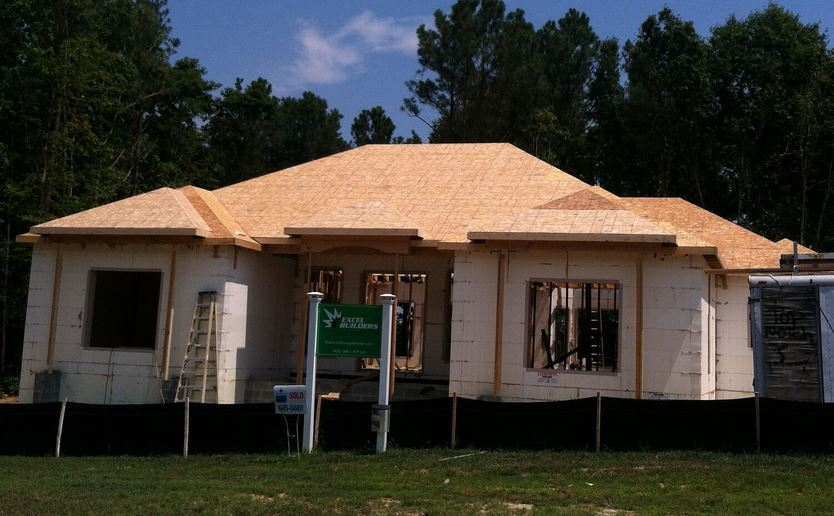
Insulated Concrete Forms (ICF) Vs. Wood-Frame Construction

Insulated concrete forms (ICF) create a more energy-efficient, quiet, and healthy building than one built with wood-frame construction. ICF buildings are also more resistant to disaster, fire, insect, and moisture intrusion than wood-frame structures.
Furthermore, builders and architects can avoid the volatility and increasing costs of lumber by utilizing an easy to install ICF wall system, like Fox Block, as an excellent alternative to wood-frame construction.
Wood-Framed Construction

For over 100 years, wood-frame construction has been common in the United States because it is quick, light, renewable, and easily customizable. Wood construction also does not require heavy equipment or tools.
However, architects, contractors, and building owners must contend with several challenges with wood-frame construction: disaster-, fire- and termite-resistance, moisture intrusion, compromised indoor air quality (IAQ), noise control, low thermal mass, and rising timber costs.
7 Problems with Wood-Frame Construction

1. Added Expenses
A disaster-resistant, wood-frame building must achieve a continuous load path to the ground and be missile resistant. Building a disaster-resilient wood-framed structure is doable, but it is expensive and labor intensive. In fact, constructing a disaster-resistant wood-framed building can cost 25–30 percent more than standard wood-frame construction.
2. Increased Fire Risk
Building a wood-frame structure that is fire-resistant is challenging because wood is combustible and it is difficult to reduce the spread of flames. Wood-frame buildings are particularly vulnerable to fire damage during construction before placement of fire protection over the frame.
3. Attractive to Termites
Wood-frame construction is subject to termite problems. Termites can damage a building’s durability and cost thousands of dollars in repairs. In fact, the annual estimated expense for termite damage and control measures in the U.S. is $5 billion. Termite protection for wood-frame construction is challenging and requires a qualified professional and specialized equipment.
4. Moisture Accumulation
Wood-frame structures are prone to moisture accumulation in their wall cavities. Controlling moisture in the wall system of a wood-framed building is difficult because effective methods that stop moisture from entering a wall cavity may also stop the moisture from leaving the wall cavity.
5. Volatile Organic Compounds
Wood-frame buildings may contain adhesives, chemicals, and volatile organic compounds (VOC) that compromise IAQ. VOCs emissions may cause eye, nose, and throat irritations, headaches, nausea, and damage to the kidney, liver, and central nervous system.
6. Harder to Soundproof
For wood-frame wall construction, soundproofing features are required to ensure a quiet and peaceful home. Reducing noise in a wood-frame building is accomplished by limiting sound vibrations with insulation, stud placement, or extra mass within the wall cavity.
7. Low Thermal Mass
Wood has low thermal mass. Therefore, wood-framed structures are not as innately energy-efficient as buildings constructed with high thermal mass products like stone, adobe, and Fox Blocks insulated concrete forms.
ICFs Vs. Wood-Frame Construction

The Fox Block ICF wall system is easier to install and more energy-efficient and noise-reducing than wood-frame construction. The Fox Block system is also healthier and more disaster-, fire-, termites-, and moisture-resistant than wood wall systems. Finally, ICF construction gives builders a way to avoid the volatility and rising lumber costs.
10 Reasons to Choose Fox Blocks ICF over Wood-Frame Wall Systems
1. Minimizing Unnecessary Steps
Fox Block is an all-in-one wall assembly that combines five construction steps into one, including structure, insulation, air barrier, vapor retarder, and interior-exterior finish attachment. This feature greatly accelerates project delivery by eliminating the need to coordinate multiple trades, while achieving all of the wall system’s objectives.
2. Increased Energy Efficiency
Fox Blocks, with an R-value of 23, are energy-efficient and exceed ASHRAE/ANSI 90.1 energy code requirements. In fact, houses built with ICF exterior walls typically require 32 percent less energy to cool and 44 percent less energy to heat than comparable wood-framed homes.
3. High Thermal Mass
The high thermal mass of Fox Blocks contributes towards a high-performing, energy-efficient structure. High thermal mass materials absorb and store heat energy and help stabilize temperature shifts within the structure by slowing the rate of heat transfer.
4. Reduction of Noise Transfer
Sound transmission tests concluded that less than a third of sound passes through ICF walls than wood-frame walls filled with fiberglass insulation. Fox Blocks achieve a Sound Transmission Classification (ASTM E90) of 4-inch=STC 46, 6- and 8-inch = STC 50+.
5. Better Air Quality
Fox Blocks contain little to no VOC, keeping the air quality at a higher level.
6. Exceptional Strength
Fox Blocks are disaster-resistant: Fox Blocks, with steel reinforced concrete, are disaster-resistant and can withstand tornado and hurricane winds of over 200 MPH, and projectile debris traveling over 100 MPH.
7. Reduced Fire Risk
Fox Blocks are fire-resistant. Fox Blocks have a fire-resistance rating (ASTM E119) of 4 hours for the 6-inch blocks and 2 hours for the 4-inch blocks.
8. Deters Termites and Pests
Fox Blocks are less prone to termite damage because they because they lack organic material, which pests like termites eat.
9. Controls Moisture Intrusion
Fox Blocks provide a solid continuous monolithic concrete wall with a perm rating of less than 1.0, which controls moisture intrusion and prohibits the growth of mold, mildew, and rot.
10. Less Volatility in Material Prices
Builders and architects can avoid the volatility and increasing costs of lumber by selecting an alternative to wood-framed walls like the Fox Blocks insulated concrete forms.
Choosing an Alternative to Wood-Frame Construction

An excellent alternative to wood-frame construction is Fox Block ICF wall assembly.
Fox Block ICF structures are more resistant to disaster, fire, insect, and moisture intrusion than wood-frame buildings.
Additionally, Fox Blocks create a more efficient-efficient, noise reducing, and healthy building than wood structures. Moreover, Fox Blocks are also easy to install and provide an alternative product to combat increasing lumber prices.
Please visit Fox Blocks for more information on ICF vs. wood-frame construction.